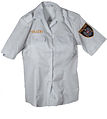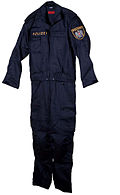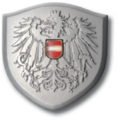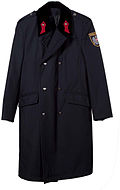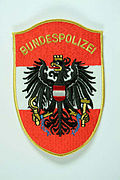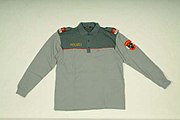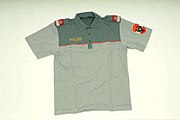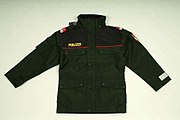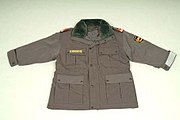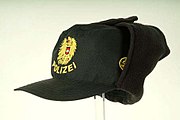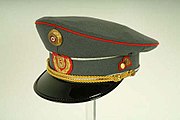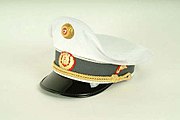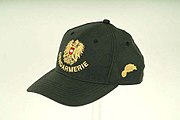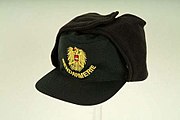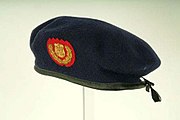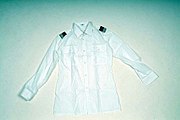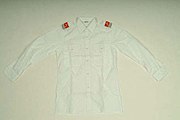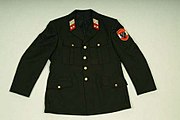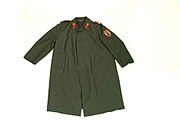Police uniform (Austria)
The Austrian police uniforms are the uniforms of the organs of the Austrian police .
Legal requirements
According to the Police Uniform Wearing Ordinance (PUTV) of the Federal Ministry of the Interior, the organs of the public security service , including members of the federal police , the flight police, the EKO Cobra , the higher service of the security authorities (legal and public medical service), are obliged to wear uniforms wear. There are exceptions for certain groups of officials, especially in the criminal police service.
The uniforms and uniform parts of police officers are protected by law in the Uniform Protection Ordinance (USV) issued in 2004. It is not permitted to wear such a uniform or uniform parts (badges, distinctions and the like) in a public place except for scenic purposes (e.g. filming) . Anyone who violates this can receive a fine of up to 360 euros or a substitute custodial sentence of up to two weeks. In 2010, an amendment to the USV was passed in which the new types of uniform, five years after their introduction, are also taken into account. In this amendment, the old green and gray types of uniform were placed under protection by the security guards and the gendarmerie until the end of 2014.
Basics
If two or more uniformed employees work together on the same field service, they have to be uniformly adjusted according to official admissibility. The respective commander makes the relevant orders. In principle, however, employees can choose the most appropriate work clothing for the service themselves, taking into account the prevailing weather conditions. The headgear belonging to the respective adjustment must always be worn. Exceptions are only permitted when performing the office work, when using vehicles, for tactical reasons and when the service cannot be achieved without endangering the employees. When wearing the uniform shirt or blouse, all buttons must be closed.
The basic color of distinctions is at the staff of the legally qualified service Bordeaux Violet , at the staff of the wax body federal police, the police officials of the medical service, police pastors and the guest musicians madder . Since 2016, new, standardized distinctions have been issued, the basic color of which is uniformly crimson . The distinctions are to be attached to the designated places of the standardized or permitted types of uniform, the postponement distinctions are to be worn on the respective outer clothing. If an employee is appointed to a new post that involves a change in the official title or the description of use, the corresponding distinction can already be worn at the time of appointment (delivery of the decree). Distinctions that no longer correspond to the current rank of an employee or that originate from previous guards may no longer be worn.
If the deputy general director for public security (BL-II-B-1) and the heads of departments II / 1 and II / 2 in the general directorate for public security are members of the legal service, the division head II-B-1 the same distinction as the chief of police or security director and the heads of department II / 1 and II / 2 the same distinction as the police vice-president or police director. Other employees of the higher service, i.e. with a degree, in the Federal Ministry of the Interior, who have been granted a uniform wearing permit, are entitled to a distinction according to the official title or the description of use (commissioner, council, senior councilor, court councilor, ministerial councilor).
The uniforms
The current Austrian police uniform was designed by Barbara Mungenast and Bettina Müller. Unless otherwise stated, all types of uniform are kept in the same dark blue tone.
Combat uniform
The combat uniform is the uniform that is worn by the staff in their regular, daily duty. The members of the higher service of the security authorities are free to wear the uniform. They wear the representative uniform during regular service.
trousers
The multi-purpose trousers used in regular service are mixed fiber trousers. In the thigh area there are outside pockets with Velcro, the two back pockets are closed with zippers. There are two silver-colored, non-reflective stripes on each side of the pant legs. The pants are available in a normal version as well as a summer version with thinner fabric and a lined winter version. Waterproof overpants are available as rain protection.
Underbelly
A blue undershirt (undershirt) with short or long sleeves (if a blue shirt is worn) or a short-sleeved white undershirt (if a white shirt is worn) made of breathable material must be worn under the shirt. On the left sleeve there is the embroidered word "POLIZEI" on the lower body and next to it the Austrian flag, also embroidered.
Shirt or blouse
The long or short-sleeved blue uniform shirt or blouse, made of cotton, is worn on regular duty. The short-sleeved white shirt is permitted in hot weather. Wearing a tie with a long-sleeved blue shirt is permitted, but not compulsory.
pullover
In cold weather, a blue turtleneck sweater can be worn instead of the uniform shirt. There is also a blue wool sweater, which can be worn over the blue uniform shirt as well as over the turtleneck sweater. In the field service, wearing the sweater as the top layer of clothing is not permitted, except in vehicles and for airport staff.
jacket
There are three different types of jackets available to employees. On the one hand, the so-called multi-purpose jacket, which is equipped with many outside pockets. It has a zip-in inner lining and an unbuttonable fleece collar for cold weather and an unbuttonable rain hood. A zip-in thermal lining is also available as an option. The so-called combat jacket is a somewhat tighter and shorter cut and has fewer outside pockets. Both jackets are made of functional material ( Gore-Tex ). A light rain jacket is provided as the third jacket, which can be worn with the overpants if necessary. A signal yellow cover is provided for the traffic service.
Jumpsuit
For security operations, an overall is worn, which, depending on the unit, can also be flame-retardant. During regular service, the overall is worn by the members of the EKO Cobra, the WEGA and sometimes also by the service dog handlers.
Headgear
The blue or white plate cap must be worn during regular service, while the white cap is mandatory for transport services. The caps of the members of the federal police guard and those of the police chaplains have a madder-red cap bar, those of the members of the higher service a claret-purple. The director general for public security , the deputy director general (BL-II-B-1), the heads of authorities, the deputy heads of authorities, the employees of the application group A1 / 5 upwards, the federal chaplains and the executive officers with the rank of brigadier, major general and general wear a Plate cap with gold-embroidered cap. In appropriate weather, it is permitted to wear a winter cap with side parts that can be folded down. Wearing the woolen hat introduced in 2013 is also permitted under precisely defined conditions. A blue beret is worn on regulatory affairs . Notwithstanding this, certain units have berets in different colors. The operational units and operational trainers (instructors for operational technology, operational tactics and shooting) wear a black beret, the WEGA and the Cobra operational command wear a dark red and the duty dog handlers a light green beret. Categorized civil servants (VWgr.E2c and E2b) wear a platinum-colored emblem on their headgear, senior civil servants (VWGr. E2a) a silver-colored and senior civil servants (VWGr. E1) and members of the higher service wear a gold-colored cap emblem.
Representation uniform
The acquisition of the representative uniform is currently only compulsory for service officers in commanding function (as well as deputies), senior officers and members of the higher service. Efforts are being made to change this.
Pants or skirt
In contrast to the operational uniform, there are no thigh pockets on the uniform trousers of the representative uniform. As an alternative, a uniform skirt is available for female servants.
shirt
It is the same shirt as the combat uniform. However, it is expressly forbidden to wear the short-sleeved white shirt with the representative uniform. The use of the tie is mandatory.
Jacket or blazer
Policeman Christoph Sumann in representation uniform
As a uniform for festive occasions you wear a jacket instead of a jacket for a representative uniform, women wear a visually similar blazer. These are models with a high-necked collar variant, but not a stand-up collar, as can be found in historical Austrian uniforms. The embroidered, diamond-shaped distinctions are located on the collar wings. Executives in charge of duty carry a silver functional clasp on their left shoulder, senior EB as well as members of the higher service and also those of the police chaplaincy a gold one.
coat
For days with cold weather, you wear a uniform coat with a zip-in lining with your representative uniform. The coats of the members of the federal police guard and those of the legal service differ in the krapproten (guard body) and burgundy purple coat paroli .
Headgear
The blue plate cap is generally worn with the representative uniform; only members of the EKO Cobra are allowed to wear the beret. The director general for public security, the deputy director general (BL-II-B-1), the heads of authorities, the deputy heads of authorities, the employees of the application group A1 / 5 upwards, the federal chaplains and the executive officers with the rank of brigadier, major general and general wear a Plate cap with gold-embroidered cap.
Historical police and gendarmerie uniforms
Combat uniform
The combat uniform was the uniform worn by the servants in their regular, daily duty. The members of the higher service of the security authorities were free to wear the uniform. They wore the representative uniform in regular service. The jackets, coats and caps were dark green ("bottle green") for the police and gray ("pike gray") for the gendarmerie.
trousers
The multi-purpose trousers used in regular service were black mixed fiber trousers. In the thigh area there were outside pockets with button closures, the two back pockets were also closed with buttons.
Underbelly
A white underbelly with short sleeves made of cotton was worn under the shirt or the turtleneck.
Shirt or blouse
The long-sleeved gray uniform shirt or blouse, made of mixed fibers, was worn on regular duty. The short-sleeved gray shirt was permitted in hot weather. Wearing a tie with a long-sleeved shirt was intended.
Polo shirt
As an alternative to the shirt, there was a gray polo shirt with red horizontal stripes from 2002. There was also a long and short-sleeved version.
pullover
In cold weather, a gray turtleneck sweater could be worn instead of the uniform shirt. There was also a gray wool sweater, which could be worn over the uniform shirt as well as over the turtleneck sweater. In the field service, wearing the sweater as the top layer of clothing was not permitted, except in vehicles. Wearing the turtleneck sweater as the top item of clothing was also not permitted in the office.
jacket
Three different types of jackets were available to the staff. On the one hand the multi-purpose jacket, which was equipped with many outside pockets and was mainly worn in the regular field service. It had an unbuttonable fleece collar for cold weather and an unbuttonable rain hood. The combat jacket was a slightly tighter and shorter cut jacket with fewer outer pockets, which is mainly used in the area of law enforcement. Both jackets were made of functional material ( Gore-Tex ). The dark green fleece jacket was also available as an alternative that could be worn separately or as an inner lining for the multi-purpose jacket. These three jackets had a red stripe on the chest. Finally, the multi-purpose anorak and the police blouson were also in use, these came from previous purchases. A signal yellow cover was provided for the traffic service.
Jumpsuit
During regular service, an overall was worn by the members of the EKO Cobra (black), the WEGA (black), and sometimes also by the service dog handlers (gray).
Headgear
In regular service the green or gray plate cap was worn, in the traffic service the white one. The caps of the members of the police differed according to the usage group. The caps of the assigned officers (E2c and E2b) had a green cap, the caps of the officers on duty (E2a) had a red trim about one centimeter wide on the cap, and the caps of the senior officers (E1) had a completely red cap on. The caps of the members of the higher service and the police chaplaincy had a burgundy violet cap bridge. The heads of the authorities, the deputy heads of the authorities, the federal chaplains and the executive officers with the rank of brigadier and general wore a plate cap with a gold-embroidered visor.
In the case of the gendarmerie, the distinction was made on the basis of the color of the border around the cap bar. In the case of assigned officials, the border was red, in the case of officers in charge of duty it was silver and in the case of senior officials in gold. Here, too, the plate cap had a gold-embroidered visor from the brigadier rank. With all headgear except for the summer cap, there was a distinction between assigned officials on the one hand and those in charge of duty and senior officials on the other, in that the emblem of the latter was embroidered on the front of the cap and the corps badge on the left side of the cap bridge; this also applied to the caps of the higher service .
If the weather was appropriate, it was permitted to wear a dark blue winter cap with side panels that could be folded down. On regulatory affairs, the police wore a black beret and the gendarmerie a blue beret . Notwithstanding this, certain units had berets in different colors. From the WEGA and the Task Force Cobra was a dark red and carried a bright green beret of the dog handlers police. As an alternative to the green plate cap, a blue baseball cap could be worn with the combat uniform.
Representation uniform
The acquisition of the representation uniform was compulsory for all employees.
trousers
In contrast to the uniform, there was a red passepoil on the side seam of the trousers and no thigh pockets.
shirt
In terms of cut, it was the same shirt as the uniform, but made of white fabric. It was available in a long and short sleeved version. The use of the black tie was mandatory.
jacket
As a uniform for festive occasions, instead of a jacket, a jacket, called a uniform skirt, was worn as a representative uniform. On the collar there were the embroidered, diamond-shaped (police) or rectangular (gendarmerie) distinctions. Executives in charge of duty carried a silver functional clasp on their left shoulder, senior EB as well as members of the higher service and also those of the police chaplaincy a gold one.
coat
For days with cold weather, a uniform coat with a zip-in lining was worn with the representative uniform.
Headgear
As a matter of principle, the green or gray plate cap was worn with the representative uniform, only members of the EKO Cobra were allowed to wear the beret.
proof
- ^ Austrian police in new clothes . Article on derStandard.at from May 20, 2004.






